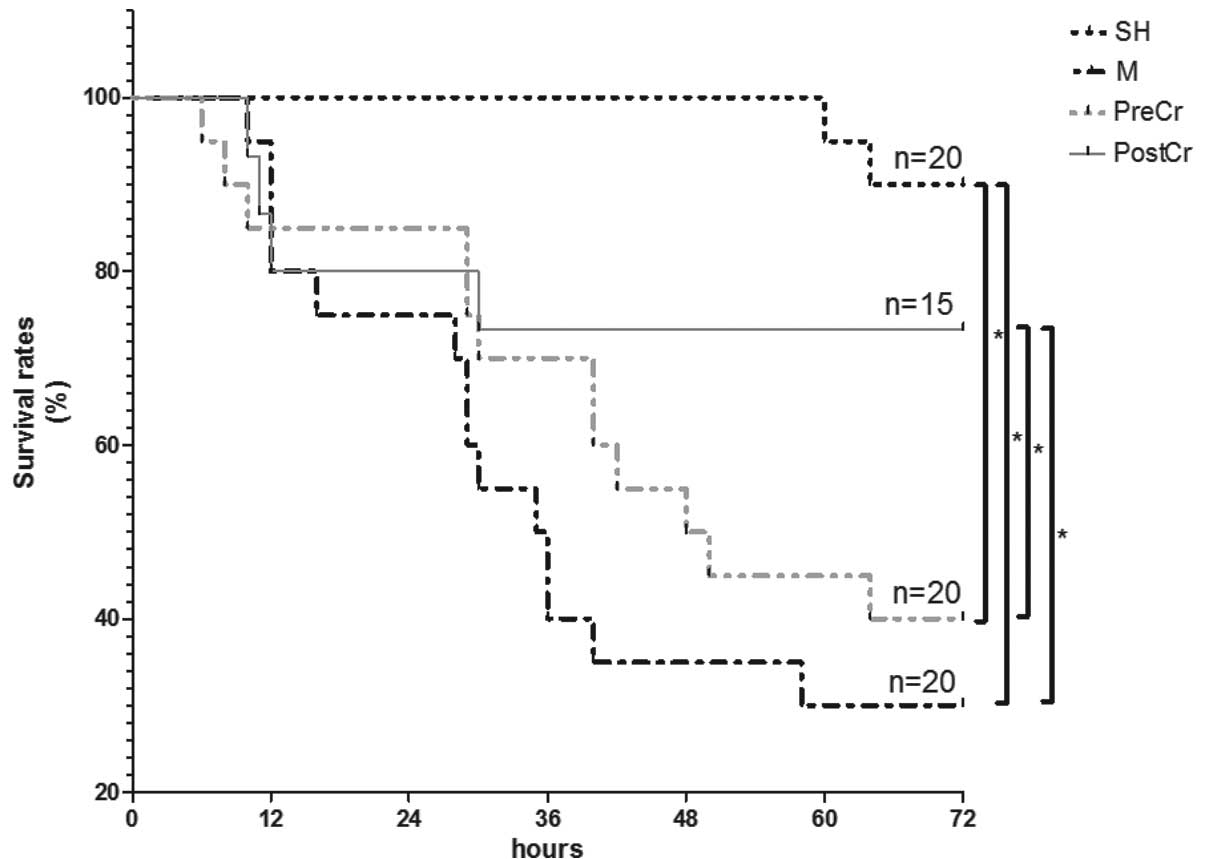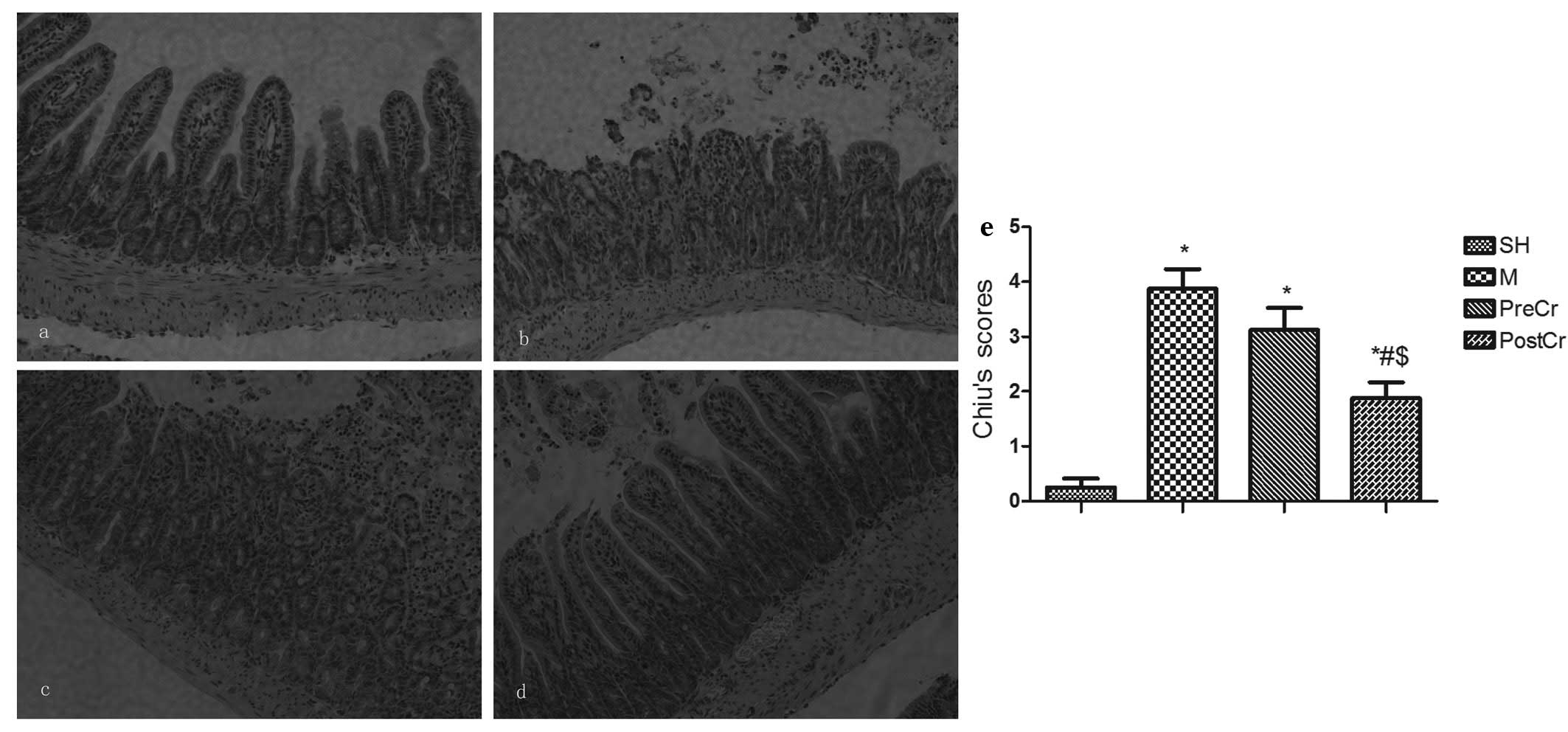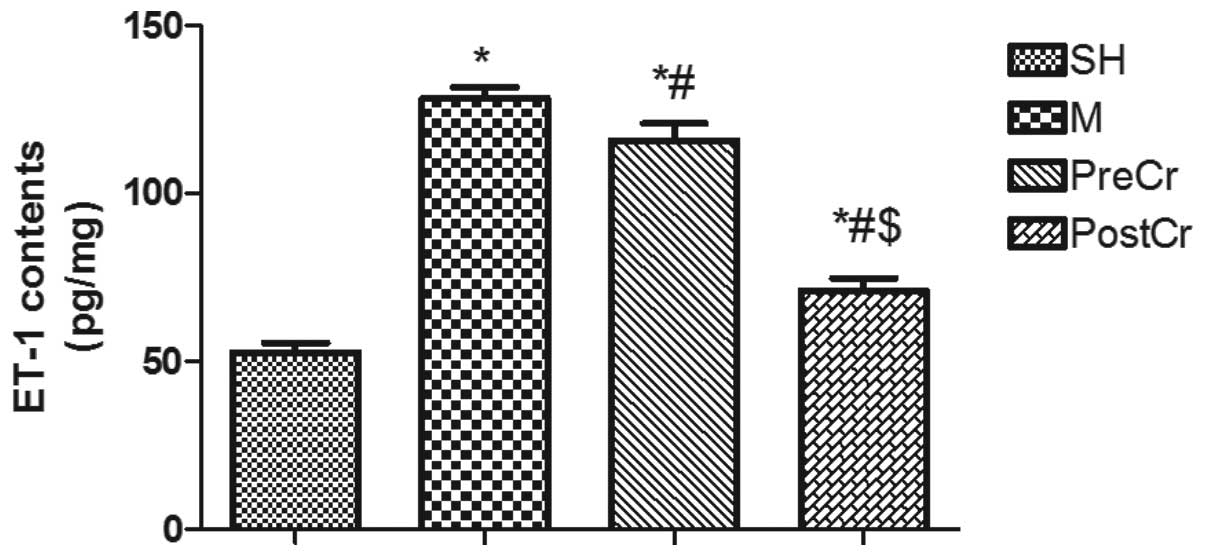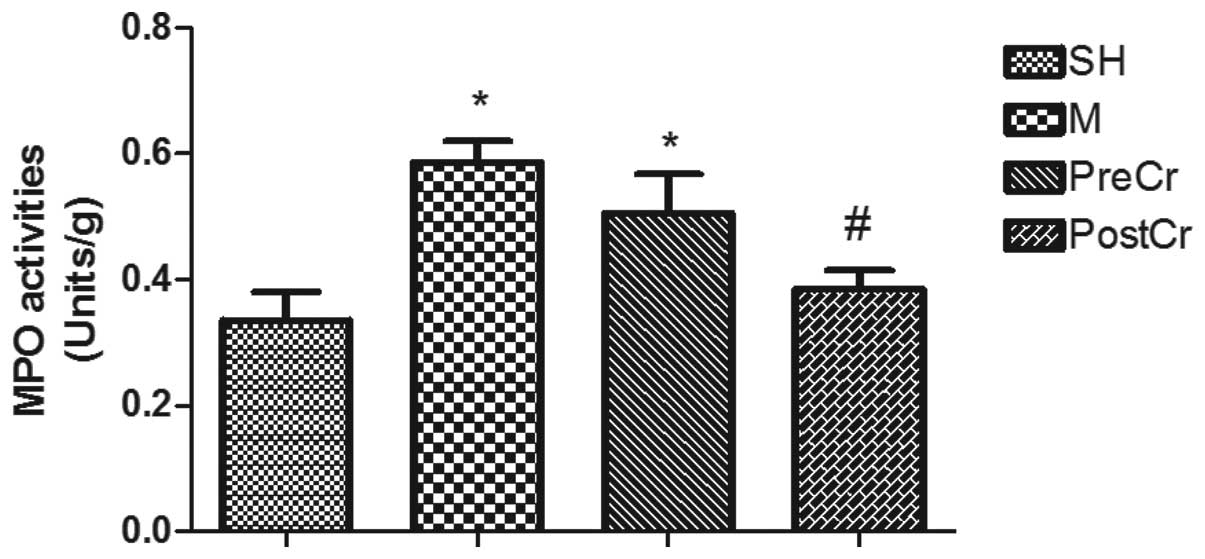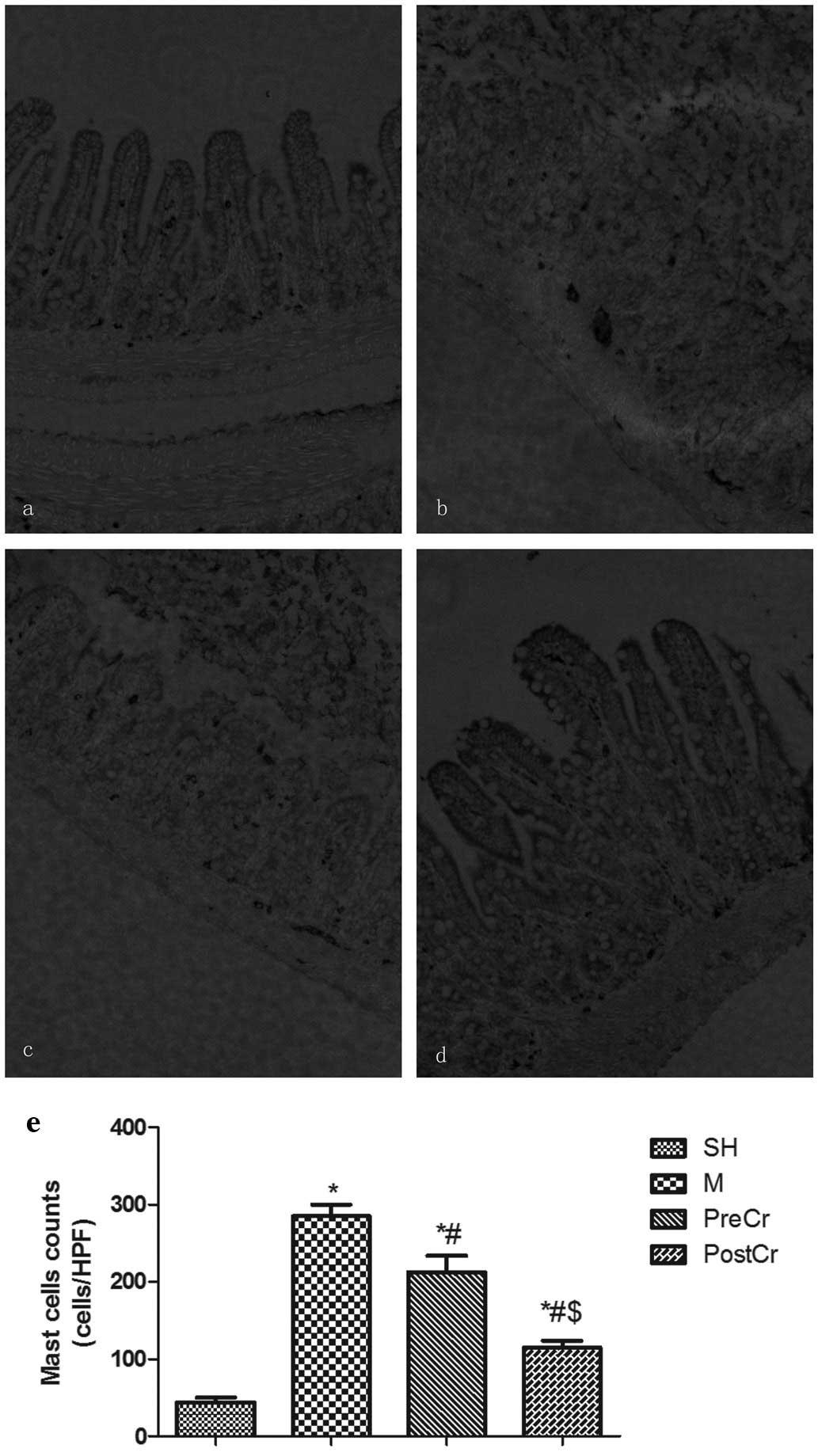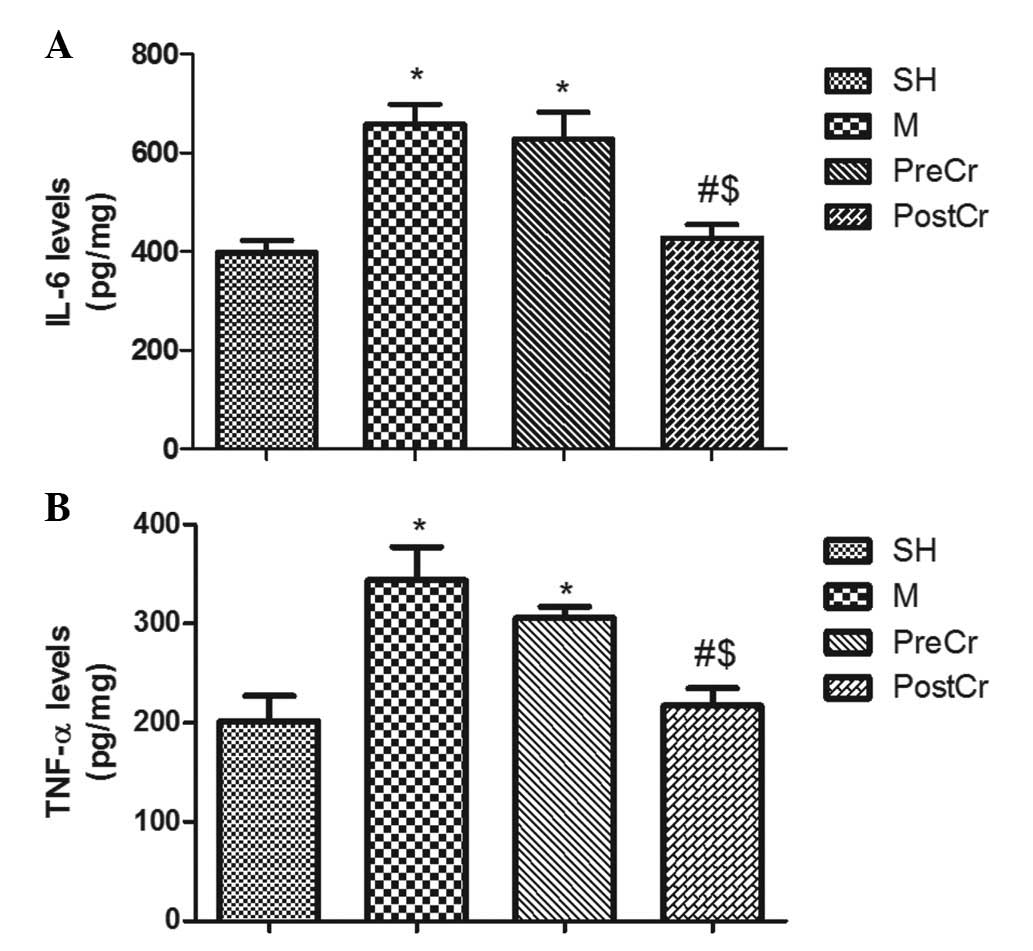|
1
|
Acosta S and Nilsson T: Current status on
plasma biomarkers for acute mesenteric ischemia. J Thromb
Thrombolysis. 33:355–361. 2012. View Article : Google Scholar : PubMed/NCBI
|
|
2
|
Debus ES, Muller-Hulsbeck S, Kolbel T and
Larena-Avellaneda A: Intestinal ischemia. Int J Colorectal Dis.
26:1087–1097. 2011. View Article : Google Scholar : PubMed/NCBI
|
|
3
|
Gupta PK, Natarajan B, Gupta H, Fang X and
Fitzgibbons RJ Jr: Morbidity and mortality after bowel resection
for acute mesenteric ischemia. Surgery. 150:779–787. 2011.
View Article : Google Scholar : PubMed/NCBI
|
|
4
|
Schiemann F, Brandt E, Gross R, et al: The
cathelicidin LL-37 activates human mast cells and is degraded by
mast cell tryptase: counter-regulation by CXCL4. J Immunol.
183:2223–2231. 2009. View Article : Google Scholar : PubMed/NCBI
|
|
5
|
Fifadara NH, Aye CC, Raghuwanshi SK,
Richardson RM and Ono SJ: CCR1 expression and signal transduction
by murine BMMC results in secretion of TNF-alpha, TGFbeta-1 and
IL-6. Int Immunol. 21:991–1001. 2009. View Article : Google Scholar : PubMed/NCBI
|
|
6
|
Wei JF, Wei XL, Mo YZ and He SH: Induction
of mast cell accumulation, histamine release and skin edema by N49
phospholipase A2. BMC Immunol. 10:212009. View Article : Google Scholar : PubMed/NCBI
|
|
7
|
Gan X, Liu D, Huang P, Gao W, Chen X and
Hei Z: Mast-cell-releasing tryptase triggers acute lung injury
induced by small intestinal ischemia-reperfusion by activating
PAR-2 in rats. Inflammation. 35:1144–1153. 2012. View Article : Google Scholar : PubMed/NCBI
|
|
8
|
Hei ZQ, Gan XL, Huang PJ, Wei J, Shen N
and Gao WL: Influence of ketotifen, cromolyn sodium, and compound
48/80 on the survival rates after intestinal ischemia reperfusion
injury in rats. BMC Gastroenterol. 8:422008. View Article : Google Scholar : PubMed/NCBI
|
|
9
|
Bischoff SC: Physiological and
pathophysiological functions of intestinal mast cells. Semin
Immunopathol. 31:185–205. 2009. View Article : Google Scholar : PubMed/NCBI
|
|
10
|
Groschwitz KR, Ahrens R, Osterfeld H, et
al: Mast cells regulate homeostatic intestinal epithelial migration
and barrier function by a chymase/Mcpt4-dependent mechanism. Proc
Natl Acad Sci USA. 106:22381–22386. 2009. View Article : Google Scholar
|
|
11
|
Wang JY, Cheng KI, Yu FJ, Tsai HL, Huang
TJ and Hsieh JS: Analysis of the correlation of plasma NO and ET-1
levels in rats with acute mesenteric ischemia. J Invest Surg.
19:155–161. 2006. View Article : Google Scholar : PubMed/NCBI
|
|
12
|
Sunose Y, Ohwada S, Takeyoshi I, et al:
Effects of endothelin receptor antagonist TAK-044 on small bowel
autograft from a controlled non-heart-beating donor model. Surgery.
130:819–825. 2001. View Article : Google Scholar : PubMed/NCBI
|
|
13
|
Caughey GH: Mast cell proteases as
protective and inflammatory mediators. Adv Exp Med Biol.
716:212–234. 2011. View Article : Google Scholar : PubMed/NCBI
|
|
14
|
Boros M, Kaszaki J, Ordogh B and Nagy S:
Mast cell degranulation prior to ischemia decreases
ischemia-reperfusion injury in the canine small intestine. Inflamm
Res. 48:193–198. 1999. View Article : Google Scholar : PubMed/NCBI
|
|
15
|
Vural KM, Liao H, Oz MC and Pinsky DJ:
Effects of mast cell membrane stabilizing agents in a rat lung
ischemia-reperfusion model. Ann Thorac Surg. 69:228–232. 2000.
View Article : Google Scholar : PubMed/NCBI
|
|
16
|
Chiu CJ, Scott HJ and Gurd FN: Intestinal
mucosal lesion in low-flow states. II The protective effect of
intraluminal glucose as energy substrate. Arch Surg. 101:484–488.
1970. View Article : Google Scholar : PubMed/NCBI
|
|
17
|
Krawisz JE, Sharon P and Stenson WF:
Quantitative assay for acute intestinal inflammation based on
myeloperoxidase activity. Assessment of inflammation in rat and
hamster models. Gastroenterology. 87:1344–1350. 1984.PubMed/NCBI
|
|
18
|
McNeil HP, Shin K, Campbell IK, et al: The
mouse mast cell-restricted tetramer-forming tryptases mouse mast
cell protease 6 and mouse mast cell protease 7 are critical
mediators in inflammatory arthritis. Arthritis Rheum. 58:2338–2346.
2008. View Article : Google Scholar : PubMed/NCBI
|
|
19
|
Funaba M, Ikeda T, Murakami M, et al:
Transcriptional activation of mouse mast cell Protease-7 by activin
and transforming growth factor-beta is inhibited by
microphthalmia-associated transcription factor. J Biol Chem.
278:52032–52041. 2003. View Article : Google Scholar
|
|
20
|
Zarpelon AC, Pinto LG, Cunha TM, et al:
Endothelin-1 induces neutrophil recruitment in adaptive
inflammation via TNFalpha and CXCL1/CXCR2 in mice. Can J Physiol
Pharmacol. 90:187–199. 2012. View
Article : Google Scholar : PubMed/NCBI
|
|
21
|
McNeil HP, Adachi R and Stevens RL: Mast
cell-restricted tryptases: structure and function in inflammation
and pathogen defense. J Biol Chem. 282:20785–20789. 2007.
View Article : Google Scholar : PubMed/NCBI
|
|
22
|
Malaviya R, Ikeda T, Ross E and Abraham
SN: Mast cell modulation of neutrophil influx and bacterial
clearance at sites of infection through TNF-alpha. Nature.
381:77–80. 1996. View
Article : Google Scholar : PubMed/NCBI
|
|
23
|
Pejler G, Abrink M, Ringvall M and
Wernersson S: Mast cell proteases. Adv Immunol. 95:167–255. 2007.
View Article : Google Scholar
|
|
24
|
Pejler G, Knight SD, Henningsson F and
Wernersson S: Novel insights into the biological function of mast
cell carboxypeptidase A. Trends Immunol. 30:401–408. 2009.
View Article : Google Scholar : PubMed/NCBI
|
|
25
|
Ozel SK, Yuksel M, Haklar G, Durakbasa CU,
Dagli TE and Aktan AO: Nitric oxide and endothelin relationship in
intestinal ischemia/reperfusion injury (II). Prostaglandins Leukot
Essent Fatty Acids. 64:253–257. 2001. View Article : Google Scholar : PubMed/NCBI
|
|
26
|
Kalia N, Brown NJ, Wood RF and Pockley AG:
Ketotifen abrogates local and systemic consequences of rat
intestinal ischemia-reperfusion injury. J Gastroenterol Hepatol.
20:1032–1038. 2005. View Article : Google Scholar : PubMed/NCBI
|
|
27
|
Philpott H, Gibson P and Thien F:
Irritable bowel syndrome - An inflammatory disease involving mast
cells. Asia Pac Allergy. 1:36–42. 2011. View Article : Google Scholar : PubMed/NCBI
|
|
28
|
Abonia JP, Friend DS, Austen WG Jr, et al:
Mast cell protease 5 mediates ischemia-reperfusion injury of mouse
skeletal muscle. J Immunol. 174:7285–7291. 2005. View Article : Google Scholar : PubMed/NCBI
|
|
29
|
Akerstrom G and Lisander B:
Antihistaminergic pretreatment prevents tissue extravasation of
albumin from intra-abdominal trauma in rats. Acta Anaesthesiol
Scand. 38:569–574. 1994. View Article : Google Scholar : PubMed/NCBI
|
|
30
|
Dharancy S, Body-Malapel M, Louvet A, et
al: Neutrophil migration during liver injury is under
nucleotide-binding oligomerization domain 1 control.
Gastroenterology. 138:1546–1556. 2010. View Article : Google Scholar : PubMed/NCBI
|
|
31
|
Spanos CP, Papaconstantinou P, Spanos P,
Karamouzis M, Lekkas G and Papaconstantinou C: The effect of
L-arginine and aprotinin on intestinal ischemia-reperfusion injury.
J Gastrointest Surg. 11:247–255. 2007. View Article : Google Scholar : PubMed/NCBI
|
|
32
|
An S, Hishikawa Y, Liu J and Koji T: Lung
injury after ischemia-reperfusion of small intestine in rats
involves apoptosis of type II alveolar epithelial cells mediated by
TNF-alpha and activation of Bid pathway. Apoptosis. 12:1989–2001.
2007. View Article : Google Scholar
|
|
33
|
Cuzzocrea S, De Sarro G, Costantino G, et
al: IL-6 knock-out mice exhibit resistance to splanchnic artery
occlusion shock. J Leukoc Biol. 66:471–480. 1999.PubMed/NCBI
|
|
34
|
Frangogiannis NG, Smith CW and Entman ML:
The inflammatory response in myocardial infarction. Cardiovasc Res.
53:31–47. 2002. View Article : Google Scholar : PubMed/NCBI
|



